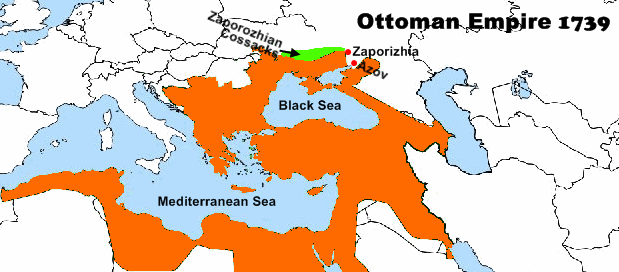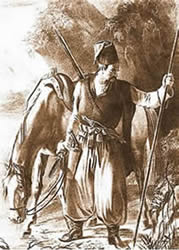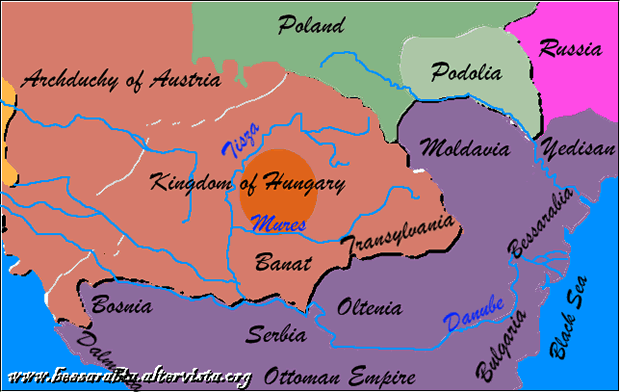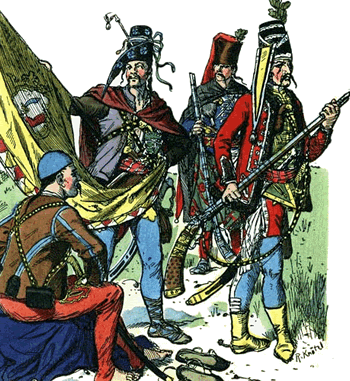![]()
![]()
Colonization under Elizabeth I of Russia (1741 to 1762)
The Serbian military settlers
The Treaty of Belgrade ended the Russo–Turkish war1 (1736-1739) on 18th September 1739. Austria lost territories acquired in the Treaty of Passarowitz on 21th July 1718 (northern Bosnia, northern Serbia, Oltenia except the Banat) which passed again to the Ottomans.

Ottoman Empire after the Treaty of Belgrade in 1739
Russia failed its aspired objective: the free passage of its ships on the Sea of Azov and on the Black Sea. Only the fortress of Azov and the city Zaporizhia fell to Russia.

Zaporozhian Cossack
in 18th century
The border between the Tsarist Empire and the Ottoman Empire followed only few places of natural barriers. Demilitarized zones at the Sea of Azov and the "Cossack state" of the Zaporozhian Cossacks2 (from Zaporozhia = land behind the rapids) separated the enemy states. These Cossacks who lived below the rapids of the Dnieper had gone under protection of the Russian czars in 1654.

Elizabeth I
To reinforce the border in the south, south-east and south-west of the empire, the tzarina Elizabeth I followed the example of her predecessor Anna Ivanovna who during her reign (1730 – 1740) settled Orthodox Slavs of the Balkans as "land militia regiments" to the southern border. The border guards got land, from which they should dispute at least a part of their living.
The Hungarians, supporting Austria in the War of the Austrian Succession (1740 - 1748) against Prussia, demanded the return of the border areas near the rivers Tisza and Mureş.

Hungary after 1739
Who didn't want to leave his country, had to be an Hungarian subject. Only 50 officers accepted this solution that involved the entry into the Hungarian nobility. Those who wouldn’t remain had to emigrate.
On 29th December 1751 Elizabeth I issued an Ukase3 in which she promised fertile land to immigrants.

Pandurs
Horwath, an officer who had voted against Hungary, formed in a short time a regiment of hussars4 and pandurs5. It was a mixture of Austrian Serbs, Greeks, Hungarians, Montenegrins, Bulgarians, Moldavians and Wallachians who was located between the rivers Dnieper and Western Buh on the Zaporozhian Cossacks' ground.
The whole district was called "New Serbia"6.

Zaporozhian Cossack
In a short time 50 villages were built. Between the new settlers and the Zaporozhian Cossacks who had free-Tatar inclination quickly arose friction, which in the long run led to unsustainable conditions.
The land of the settlers was managed without much success, because they had to spend a lot of time for the border service.
Russia's borders shifted with time towards south. In 1764 the settlements were transformed into cities and in 1783 the regiments were annexed to the regular army. So the settlement experiment was terminate without much success.
 1
1 
1 Russo–Turkish War = 4th Russo-Turkish war or 7th Austrian-turkish war
2 Cossacks =
belligerent, militarily organized inhabitants of border areas in south
and south-east of Russia and Poland against the Tartars and the Turks.
The Cossacks were recruite especially from Russian and Ukrainian peasants
who since the 15th century fled from serfdom and the economic pressure
and settled on the free steppes of the middle and lower Don. For a long
time they were independent and in the 16th century they formed kingdoms
to the rivers Dnieper and Don.
They were divide into two groups: the urban bounded Cossacks were unite
forever to the rulers of Moscow and lived in the middle Dnieper: they worked
for border defence and trade; the other group, the Zaporozhian Cossacks
lived "below the rapids” of the lower Dnieper and had their
fortified centre (Sich) on the Khortytsia island approximately from 1550
to 1775. They based their livelihood with river piracy, robbery, as mercenaries
and some agriculture. Nearly all other Cossack categories descended from
them (including the Don Cossacks, the Ural Cossacks).
In 1648 the Zaporozhian Cossacks were in revolt and tried to establish
as an independent state in face of Poland-Lithuania, the Crimean Tatars
and Ottomans, however, gradually passed under the sovereignty of the Russian
czars.
In 1775 Catherine II revoked the Zaporozhian Cossacks autonomy and in the
18th century the Cossacks were a privilege military status in the czarist
Russia. In chance for the border protection they got land near the borders.
In the 19th century the Cossacks were frequently used to suppress internal
unrest. In June 1918, after the October revolution the Soviet government
nullified all the Cossacks privileges.
3 Ukase = historic designation for a decree of the Czar
4 Hussars = light cavalry created in Hungary in the 15th century and used throughout Europe and even in America since the 18th century.
5 Pandurs = a non-linear (irregular) army made out of mainly Croats from the town of Pandur that was deployed primarily to raid behind enemy lines, attack baggage and supply trains, conduct guerrilla warfare, and to fight in extended formations.
6 New Serbia = In 1764 the designation New Serbia was changed by Catherine II in Province New Russia .


